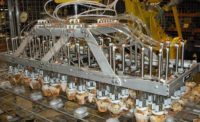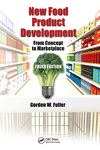Product handling systems evolve
Secondary packaging equipment features flexibility and quick changeover






The latest product handling equipment—cartoners, case erectors and packers, loaders and palletizers—features maximum flexibility in terms of product handling and packaging styles, which is good news for bakery and snack producers. Featuring quick changeover, this secondary packaging equipment offers flexible format changes and intelligent feeding, allowing brands to quickly respond to market demands.
New systems are able to create more complicated carton types, including shelf-ready display packages. For example, BluePrint Automation, South Chesterfield, VA, offers wraparound case packing equipment that can produce a variety of shelf ready packages. These include two-piece display trays with hoods, where lids are easily removed from display trays at stores, and three-quarter style cases that display the products inside the package, but still have strong corners for case stacking strength and protection on pallets.
AFA Systems Ltd., Brampton, Ontario, recently completed a new system that can handle a standard carton design and an irregular shape carton design. The system is used by Lindt to package its three-pack Rhombus or diamond-type shape carton and five-pack regular shape carton. “The system is very complicated as standard cartoners typically run a square or rectangle type carton through the machine,” says Eric Langen, director of sales and marketing.
SOMIC America Inc., Eagan, MN, has been working with its European customers to pack products in complex assemblies. For example, tray designs that incorporate product retention features to ensure pouches remain standing while on display are commonly adapted to the tray forming and loading process. “In addition, forming corner posts for club store display trays to maximize top load compression for heavy products is a material and cost savings opportunity when replacing hand-formed tray designs," says Peter Fox, senior vice president of sales.
Schubert North America, Charlotte, NC, offers cartoners that produce shelf-ready cartons. “With simple tool replacement we can run clamshells or trays (recyclable material), on the same machine. Then, depending on the demand our clients will get from retailers, they will be able to quickly adjust to their specific need,” says Giorgio Calorio, sales account manager.
Advancing robotics
The application of robotics in case packing applications continues to increase. This trend is being fueled by the decrease in capital costs and total cost of ownership of the equipment, and by the availability of more user-friendly programming tools. Robotics is gaining popularity because it can handle delicate products gently and run a variety of package styles.
Craig Souser, president, JLS Automation, York, PA, says the current labor shortage also is fueling demand for robotics in package handling. As baby boomers retire, which is happening at an increasing rate, younger generations are not stepping into those jobs. “We have customers that cannot expand their capacity due to labor shortages. As a result, we’ve had to make our systems more flexible and simpler to troubleshoot and operate. Turnover is a given for many of our bakery customers.”
Schubert North America is implementing open platform communications (OPC) interfaces with its client’s enterprise resource planning (ERP) systems. “Depending on the market demand, we can adjust robots to pre-defined varieties of packaging that are customer-oriented. Robotic machines can easily adjust without losing efficiency, as opposed to standard machines that require adjustments from operators,” Calorio says.
As part of this robotics trend, end-of-arm tooling (EOAT) for picking and handling food products and packages continues to advance. New systems can handle delicate bakery goods at high speeds without damaging product. Suction cup and vacuum technology has become more precise to mitigate vibration. This allows more pick-and-place solutions to be developed for the bakery and snack food industry.
Gripper manufacturers are constructing their devices out of polymers that will not damage delicate products. “Programmable pressures and shapes allow grippers to be used on products that have many different form factors,” says Dean Elkins, segment leader, handling, Yaskawa America Inc., Motoman Robotics Div., Miamisburg, OH. In addition to meeting sanitation requirements, gripper manufacturers also are designing their products to address the needs of higher ingress protection (IP) ratings.
EOAT advances in gripper technology, as well as continued development of new vacuum picker designs, offer gentle product handling. However, the biggest limitation is attaining high speeds, according to Fox. “This is why SOMIC uses mechanical vertical collation. It enables us to run at high speeds while collating without damaging fragile products. Pushing of product groups on low-friction materials or dynamic shifting tables eliminates the concern of damaging thin films, which is especially critical in MAP packaging,” he notes.
Schubert North America is applying its knowledge of 3D printing technology to precisely shape EOAT to match specific products. “In case of new products and uncertainty about the maximum speed we can achieve, we have test lines available where we can simulate production operations. Test tools also can be shipped to customer facilities for final considerations,” Calorio says.
Ongoing innovations
Product handling equipment recently introduced to the bakery and snack market incorporates many of the aforementioned features. For example, AFA Systems Ltd. has unveiled the HD-CMA Continuous Motion Autoload Cartoner, which can handle 600 items per minute, including regular and irregular shaped cartons. A patented Sure-Load system ensures that product remains in the carton after loading and before closing, which improves efficiency as there are fewer rejects at the checkweigher. Push-button changeover occurs in less than 10 minutes.
BluePrint Automation offers the Spider 300v Packing System, which utilizes Vision Guided Delta Robots to pattern form arriving products onto a pick belt for robotic placement into cases, trays or cartons either in a vertical or horizontal pack pattern. The system allows for random product arrival at high speeds and provides flexibility in packaging formats.
JLS Automation has introduced a Next Generation system that integrates robotic control and programmable logic control (PLC) into one system, but more importantly takes hygienic design to a new level. The vision-guided Peregrine robotic cartoning system loads flexible bags, flow packs and other primary packages into tri-seal and other style cartons at high speeds. It minimizes changeover while meeting production needs for small batches, Souser notes.
Syntegon Technology GmbH, New Richmond, WI (formerly Bosch Packaging Technology) has introduced the Paloma HE top loader and a wrapper infeed for use in harsh environments. The top loader picks and places products into flow wrappers, cartoners or thermoformers with vision-guided, high-speed Delta Robots. “The machine and its components are made from stainless steel. All parts that come in contact with the product are easy to clean (foam-and-rinse) to prevent contamination,” says Kelly Meer, product manager.
Syntegon Technology GmbH also has introduced the entry-level Pack 102 horizontal flow wrapper, which uses a Fanuc Scara robot and is suitable for small to mid-sized bakery and snack producers. The robot picks products directly from two baking trays and places them into the infeed chain of the Pack 102 flow wrapper. Machine vision is used to find and place products into the infeed.
Yaskawa America Inc., Motoman Robotics Div. recently introduced the HC20 collaborative robot. It features a 20-kg lift capacity and 1,700-mm reach, which is ideal for case packing and palletizing applications, according to Elkins. The company also has introduced the MotoMini, which is designed for low payload material transfer and case packing applications.
A-B-C Packaging Machine Corp., Tarpon Springs, FL, has introduced the Model 72AN compact palletizer for bakery and snack processors that have limited floor space and a reduced budget. The palletizer’s footprint is up to 30 percent smaller than conventional low-level machines. An intelligent control package offers simple, touchscreen control of operation, changeover, production data and diagnostics.
Robert King, principle applications engineer, MGS, Maple Grove, MN, says that many bakery and snack producers are experiencing labor shortages and turning to automation to improve production. In response, MGS offers tray denesting machines that maximize productivity with fewer employees. MGS recently introduced the Vortex screw-style tray denester, which features an easy wash-down design. The machine handles plastic, paper, fiber-molded and clam-shell trays, as well as buckets and tubs. It is easy to integrate into existing filling lines and its pushbutton interface makes it easy to operate at up to 300 cycles per minute, King notes.
Looking ahead, manufacturers see more robotic systems being integrated into traditional cartoning and case packing technology. This advance will provide end users with even more flexibility in their quest to meet changing customer demands.
Looking for a reprint of this article?
From high-res PDFs to custom plaques, order your copy today!











